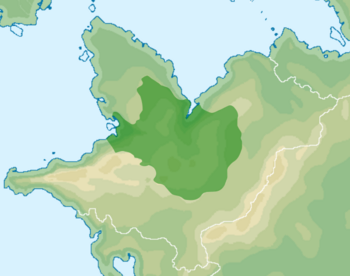Chaan Dynasty
Chaan Chaan Nimja | |||||||||
|---|---|---|---|---|---|---|---|---|---|
| 300 BC - 250 AD | |||||||||
 A map of the Chaan Mutul at its greatest extend | |||||||||
| Capital | Yux | ||||||||
| Common languages | Classical Mutulese | ||||||||
| Religion | White Path | ||||||||
| Government | Monarchy | ||||||||
| K'uhul Ajaw | |||||||||
| Historical era | classical | ||||||||
| 340 BCE | |||||||||
| 300 BC | |||||||||
| 315 BC–300 BC | |||||||||
| 250 AD | |||||||||
| |||||||||
The Chaan dynasty (Mutli : Chan Nimja) was the second divine dynasty of the Mutul, preceded by the 50 years long Nakabe Revolt, and then followed by the War of the Princes. It lasted for over 470 years, from 320 BC to 250 AD, and is considered a golden age of the Mutulese history.
The period saw a number of limited institutional innovations. The Chaan government centralized the prerogatives traditionally reserved to rulers, such as the control of the roads and of waterways, with strengthened control over marketplaces, banks, and various lenders, while the aristocracy continued to be responsible of the transport of goods and products from markets to markets, from the producer to the consumer. Science and technology during the Chaan period saw significant advances including the process of papermaking and the use of negative numbers in mathematics.
Etymology
The Dynasty was not named after its founding clan's name, but instead from it's glyph-emblem, representing a snake. The Ahk Family, so called because many of its members had the "Ahk" in their glyphic name, chose the snake, Chan or Kaan depending on the dialect, to honor the Vision Serpent, the gateway to the divine realm and a reminder of the family's origins in Divination.
History
Foundation
Traditional Myth
According to traditions and the records kept by the Chaan, the Ahk lineage began when one of K'o's, the First K'uhul Ajaw, daughters gave birth to a son, Siyaj Ahk, fathered by a minor divinity of the underworld. After proving the veracity of her words to her father, by quoting in the Underworld's language her lover's titles, she was given the direction of a Temple covering a door to the Underworld. She gave birth during the travel, and the child was carried in a turtle shell. During his childhood, the half-god, great-grandson of Chak and son of a god of the Underworld, proved to be a great Oracle, capable of communicating with both the upper and under worlds. He became famous for his wisedom and prophecies, and was even invited to his uncle's, the new K'uhul Ajaw, court despite his unclear paternity and the possible threat he could become to the Divine Lord's authority. He nonetheless served as the main priest and oracle of the court, given the charge of Kaminyajunlyu main temple and the direction of the associated school for the elite. He notably became the personal teacher of the B'ah Ch'ok Ajaw and then his main advisor.
It was through Siyaj Ahk's origins that the Ahk Lineage explained their gift in divination and long held positions as oracles and seers. They would remain important nobles at the Paol'lunyu court for all of the Dynasty's duration. During the second half of the Dynasty, the Extensive Period, an Ahk and close friend of the Ka Lineage received lands from the latter in the recently conquered north, with the task of establishing a city capable of both protecting the western border of the Mutul against aggressors and serving as a trade hub with the Chik'inli. The legend says that it's in a ritually-induced vision that the perfect location for that city was revealed to the Ahk, who then founded the city of Yux. Yux would remain a major vassal to the Ka and their city of Nakabe, protecting their western flank against ennemies and serving as a major source of both funds and men for their wars.
But ultimately, Yux loyalty's to Nakabe was weakened by the latter's growing centralization, always increasing demand, incessant warfare, and complete abandon of its vassal against the Yakalmek Kingdom, a nominal allies of the Ka who nonetheless continued to raid and harass Yux. This led to Iztam K'an Ahk's rebellion in 340 BC, supported by Izapak, the rival of Nakabe.
Yux-Izapak Co-Dominion
Itzam K'an Ahk's son, Wabak'el Chaan married Lady Ek Janab, solidifying Yux's alliance with Izapak. When the K'uhul Ajaw of Izapak died without an heir, it's Lady Ek Janab who secured the throne for herself. Thus both Mutal ended up in a co-dominion, ruled by two K'uhul Ajaw married to one another, once Wabak'el Chaan rose to the throne of Yux too.
This joint rule would last from 327 to 300 BC and would see the defeat of the Ka Dynasty and the de-facto re-unification of the Mutul in 315 BC. However, it's not until the death of both monarchs that their son, Yax Chaan Ahk would unify both crown and claim the Divine Lordship of all of the kingdom, officialy starting the Chaan Dynasty.